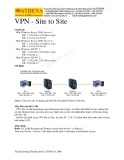
Tran Quy Nam, Vu Huu Tien
Abstract: This study proposes to test a combination
model between CNN network and XGBoost algorithm for
weather image classification problem. The proposed
model uses deep learning network, namely CNN for
feature extraction, then feeds the features into the
XGBoost classifier to recognize the images. The model
applies a test dataset which is a set of 11 different image
classes collected under different weather patterns. The
same dataset is also tested with other deep learning
networks including Xception, InceptionV3, VGG19,
VGG16 according to the general principle of parameters,
keeping the original image for comparison. The test
results show that the CNN-XGBoost model gives the best
accuracy results, suitable for application in evaluating and
classifying photos describing different types of weather.
Keywords: CNN, XGBoost, photo, weather.
I. INTRODUCTION
Application of image processing in weather
assessment and forecast is an important field in human
life and socio-economic development. The problem of
weather image processing also plays an important role in
forecasting and analyzing the effects of weather in the
field of security and defense. In fact, there have been
many studies on processing and analyzing weather images
using machine learning techniques, deep learning...
applied in the development of self-driving cars, intelligent
traffic systems.
Accurate processing and identification of weather
photos taken from satellites or weather observation
stations is an important method in weather forecasting,
warning consequences, severity of natural disasters,
weather conditions, and weather conditions or bad
weather. The process of monitoring and analyzing
satellite cloud images is a highly effective method for
weather forecasting and warning through a high-
resolution satellite cloud image acquisition system.
Weather photo analysis helps to assess the actual
situation, factors that have positive or negative impacts on
socio-economic activities such as agriculture, forestry,
fisheries, tourism, etc. At the same time, it helps the
weather forecasters actively monitor, analyze and detect
dangerous weather phenomena and dangerous weather
systems affecting human life.
Recognizing weather phenomena that significantly
affect many aspects of our daily lives, such as weather
forecasting, road condition monitoring, transportation,
agricultural and forestry management and natural
environment detection. In contrast, very few studies have
attempted to categorize images of actual weather
phenomena, often relying on visual observations from
humans. To our knowledge, traditional man-made visual
distinctions between weather phenomena are time-
consuming and error-prone. Although some studies have
improved the accuracy and efficiency of weather
phenomenon recognition using machine learning, they
have identified fewer types of weather phenomena.
In autonomous vehicle control, the correct
identification of photos to assess the weather situation and
make decisions about operating the operating mode of the
traffic vision assist system or ADAS (advanced driver
assistance system) play an important role. At the same
time, the weather image recognition problem contributes
to analysis and gives meaningful information on some
other outdoor monitoring systems.
Researching weather image recognition in computer
vision helps build weather biometric devices that sense
and interpret weather conditions through image data.
During the driving process, being aware of extreme
outdoor weather patterns can have a significant impact on
road traffic safety. Through the analysis of weather
images, it helps to detect bad conditions early and warn
drivers. At the same time, highly reliable automatic
recognition of weather situation images provides valuable
information for automated IoT systems, self-driving
vehicles, and vehicle control systems.
Thus, the problem of automatic and high-quality
image classification of weather phenomena can provide a
reference for future studies on weather image
classification, disaster prediction and weather forecast.
Tran Quy Nam and Vu Huu Tien
Posts and Telecommunications Institute of Technology
WEATHER IMAGE CLASSIFICATION
BASED ON COMBINATION OF CNN AND
XGBOOST
Contact author: Tran Quy Nam
Email: namtq@ptit.edu.vn
Manuscript received: 3/2023, revised: 5/2023, accepted: 7/2023.
No. 03 (CS.01) 2023
JOURNAL OF SCIENCE AND TECHNOLOGY ON INFORMATION AND COMMUNICATIONS 69

WEATHER IMAGE CLASSIFICATION BASED ON COMBINATION OF CNN AND XGBOOST
Therefore, this study proposes a model that uses a
combination model of VGG16 (based on CNN) with
XGBoost algorithm to classify weather photos. The
reason for choosing XGBoost is because it is a relatively
new algorithm and has a fast processing speed.
Experimental results will be compared with some other
traditional models and presented in the next sections.
II. LITERATURE REVIEW
In fact, there have been many studies using machine
learning models, deep learning to identify weather photos
around the world. One of them is a study conducted by
Kang et al [1] with image data captured from outdoor
visualization devices using a deep learning based weather
image recognition framework by considering the three
most common weather conditions, including fog, rain, and
snow, in outdoor scenes. The results of extensive tests
based on two GoogLeNet and AlexNet networks,
conducted on the weather image data set, gave good
results and high feasibility. Mohammad et al. [2]
performed a study aimed at classifying weather images
using a CNN network with transfer learning. Four
architectures CNN, MobileNetV2, VGG16, DenseNet201
and Xception are used to perform weather image
recognition and classification. Transfer learning is used to
speed up the model training process to get better
performance and run faster. The proposed methods are
applied to weather images including six layers, cloudy,
rainy, sunny, sunrise, snowy and classified fog. The test
results show that Xception has the best average accuracy
of 90.21% with an average training time of 10,962
seconds and MobileNetV2 has the fastest average training
time of 2,438 seconds with an average accuracy is
83.51%.
Haixia et al [3] conducted research to build a new
deep neural network (CNN) named MeteCNN to classify
weather phenomena. Meanwhile, the study uses a weather
phenomena dataset (WEAPD) containing 6,877 images
with 11 weather phenomena, which has more categories
than the previous dataset. The classification accuracy of
MeteCNN on the WEAPD test suite is about 92% (with
image augmentation), and the test results show the
superiority and efficiency of the MeteCNN model.
Mohamed et al [4] introduced a model that automatically
extracts weather information from photographs based on
deep learning and computer vision. WeatherNet model is
trained, based on transfer learning using ResNet50
network architecture to extract weather information and
different images such as sunrise, sunset, day and night,
rain, snow and fog for different weather conditions.
WeatherNet shows good performance in extracting
weather information from user-defined images or from
video streams with weather images.
In the paper of Elhoseiny et al. [5], the authors studied
weather classification from images using CNN network
combined with transformation learning. The authors’
approach based on the Weather-CNN network with
ImageNet-CNN gives good results compared to some
other methods in the weather classification problem. The
authors’ approach achieves a standardized classification
accuracy of 82.2% instead of 53.1% for the other method.
Manthan et al. [6] classified images of weather
patterns using convolutional neural networks and deep
learning algorithms. The results show that the
classification model is quite good, proving that it can
combine image recognition capabilities, allowing weather
classification of certain input images, such as sunshine,
rain,... Qasem et al. [7] studied weather image classifier
recognition using ResNet-18 neural network to provide
weather image classification. The model uses transfer
learning technique based on ResNet-18 that has been pre-
trained on ImageNet image set to train and classify the
weather recognition image dataset into four classes
including: sunrise, sun morning, it was raining and it was
cloudy. Research results show that the proposed model
achieves a remarkable classification accuracy of 98.22%
which is superior to other types of models trained on the
same data set.
The above studies have high accuracy by using many
new weather imaging techniques from the available data
set (image augmentation), combined with techniques to
refine model parameters. While the research in this paper
uses the original image, does not generate new images by
rotating, flipping, etc. to ensure the authenticity in
comparing the deep learning models. At the same time,
the applied model will freeze the training parameters and
only use the original model for the weather image
classification problem.
III. METHODOLOGY
A. Proposed model for research
This study proposes a model using a convolutional
neural network (CNN) trained VGG16 for feature
extraction and the XGBoost algorithm for classification
and they are both applied into the classification of the
classes of weather images (see Figure 1). To unify the
comparison parameter, the images are uniformly sized
before being fed into the training and classification
models.
XGBoost algorithm stands for Extreme Gradient
Boosting, a highly efficient machine learning algorithm
based on a combination of techniques to adjust error
weights on weaker models to create a stronger model.
XGBoost algorithm principle is based on decision tree
and gradient enhancement technique to give the optimal
model. Sequentially generated new trees minimize the
error from the previous tree by relearning the error of the
previous tree, performing error correction to get a better
tree. XGBoost was originally introduced by Chen and
No. 03 (CS.01) 2023
JOURNAL OF SCIENCE AND TECHNOLOGY ON INFORMATION AND COMMUNICATIONS 70

Tran Quy Nam, Vu Huu Tien
Guestrin (2016) to improve the performance and speed of
decision trees by the principle of gradient enhancement
(gradient-boosted) [10].
Figure 1: CNN-XGBoost Network Architecture
According to the description of the XGBoost
algorithm given by authors of Chen and Guestrin [10],
XGBoost works as follows:
For a given dataset with n samples and m features D =
{(xi, yi)} (|D| = n, xi
∈
Rm, yi
∈
R), apply a model that
combines the tree uses K enhancement functions to
predict the output.
𝑦𝑖=∅(𝑥𝑖)=∑𝑓𝑘(𝑥𝑖),𝑓𝑘∈𝐹 (1)
𝐾
𝑘=1
where F = {f(x) = wq(x)} (q : Rm → T, w
∈
RT) is the
space of the regression tree (also known as CART). Here
q is a representation for the structure of each tree,
mapping a data sample to the corresponding leaf index. T
is the number of leaves on the tree. Each fk corresponds to
an independent tree structure q and leaf weight w.
To find out the set of functions used in the model, the
following normative objective function minimization
algorithm:
ℒ(∅)=∑𝑙(𝑦𝑖,y𝑖)
𝑛
𝑖=1 +∑Ω(𝑓𝑘)
𝐾
𝑘 (2)
where Ω(f)=γT+1
2𝜆||w||2
Where, l is a differentiable convex loss function used
to measure the difference between the predicted value 𝐲𝐢
and the actual value yi. The second component Ω is the
penalty for model complexity (e.g. function of a
regression tree). The additional normalization components
smooth the learned final weights to avoid over-fitting.
Visually, the normative objective tends to choose a model
that uses simple but highly predictive functions.
The Gradient Tree Boosting algorithm is performed
when the model is continuously trained in the way of
feature addition. Formally, if yi(t) is the i-th prediction
value at the tth loop, the algorithm will need to add the ft
component to reduce the objective function as follows:
ℒ(𝑡) =∑𝑙(y𝑖,𝑦𝑖(𝑡−1) +𝑓𝑡(𝑥𝑖))
𝑛
𝑖=1 +Ω(𝑓𝑡) (3)
The second order approximation is used to optimize
faster than the objective function in the algorithm
implementation.
ℒ(𝑡) ≅∑[𝑙(y𝑖,𝑦(𝑡−1)+𝑔𝑖𝑓𝑡(𝑥𝑖))+1
2ℎ𝑖𝑓𝑡2(𝑥𝑖)]
𝑛
𝑖=1 +Ω(𝑓𝑡) (4)
where 𝑔𝑖=𝜕𝑦
(𝑡−1)𝑙(y𝑖,𝑦(𝑡−1)) and ℎ𝑖=
𝜕𝑦
(𝑡−1)
2𝑙(y𝑖,𝑦(𝑡−1)) is the first and second order gradients
on the loss function. We can remove the constants to
obtain a simpler objective function as follows in step t.
ℒ(𝑡) =∑[g𝑖𝑓𝑡(𝑥𝑖)+]𝑙(,𝑦𝑖(𝑡−1) +1
2ℎ𝑖𝑓𝑡2(𝑥𝑖))
𝑛
𝑖=1 +Ω(𝑓𝑡) (5)
Definition that Ij = {i|q(xi) = j} is the set representing
the composition of leaf j. We can calculate the optimal
weight 𝑤𝑗∗ of leaf j by:
𝑤𝑗∗=− ∑𝑔𝑖𝑖∈𝐼𝑗
∑ℎ𝑖+𝜆
𝑖∈𝐼𝑗 (6)
Calculate the corresponding optimal value by:
ℒ(𝑡) =−1
2∑(∑𝑔𝑖𝑖∈𝐼𝑗)2
∑ℎ𝑖+𝜆
𝑖∈𝐼𝑗
𝑇
𝑗=1 + γT (7)
Equation (7) can be used as a scoring function to
measure the quality of a tree structure q. This score is the
same as the classification score for evaluating decision
trees, except that it is computed for a wider range of
objective functions.
In essence, the XGBoost algorithm uses gradient
boosting techniques to identify new trees that are
generated on the basis of minimizing the error from the
previous tree, adjusting the error weight to get a good
tree. Therefore, the faulty points in the previous tree will
have a better chance of being corrected in the next tree.
The proven XGBoost algorithm optimizes speed and
performance for building predictive models. At the same
time, the XGBoost algorithm uses a variety of data
formats, including tabular data of different sizes and
layered data types.
For the comparative models, this study applies the
networks VGG16, VGG19, InceptionV3 and ResNet151
with the same image size, no additional image generation,
also no fine-tune of parameters and use softmax function
to classify weather images. In which, VGG16, VGG19
No. 03 (CS.01) 2023
JOURNAL OF SCIENCE AND TECHNOLOGY ON INFORMATION AND COMMUNICATIONS 71

WEATHER IMAGE CLASSIFICATION BASED ON COMBINATION OF CNN AND XGBOOST
was born in 2015 and is a CNN network with 16 layers
and 19 layers respectively. InceptionV3 was born in 2016,
is the 3rd generation of Google's CNN network
architecture, with less than 25 million parameters. ResNet
151 belongs to the family of CNN networks of the ResNet
(Residual Network) family, born in 2015 with shortcut
architecture between hundreds of network layers to
contribute to overcoming the phenomenon of vanishing
gradients. The general model applied on the matching
networks for the weather image classification problem is
described in Figure 2.
Figure 2: Model of comparative networks
B. Description of dataset for implementation
This study used the WEAPD dataset of 6,862 images
[9] collected under various weather patterns (Figure 3) for
implementation of proposed model.
Figure 3: Example of dataset WEAPD
In the WEAPD dataset, the weather images are
divided into 11 different image categories (Figure 4). We
can see that the dataset is imbalanced (imbalance number
of images) between the image data classes. In order to
unify the comparison parameters, this study did not
duplicate the images through performing under-sampling
and over-sampling techniques to obtain balanced dataset.
In other words, both the proposed model and the matching
model use the original dataset, which is still unbalanced
data from the original data.
Figure 4: Number of images by labels
IV. EXPERIMENT AND RESULTS
We leave out the fully connected layers of VGG16,
keep only the feature extraction and use XGBoost to
classify the weather images. There are some
hyperparameters of models, such as tree depth max_depth
= 3, min_child_weight = 1, n_estimators = 100, and
objective using multi:softprob in XGBoost algorithm. The
data is divided 80% for the training part, and 20% for the
test of the model using the random splitter. The model test
results achieved an accuracy of 80.41%.
The confusion matrix showing correct and mistaken
classification between 11 weather data classes of the
proposed model is shown in Figure 5 below.
Figure 5: Confusion matrix
For the comparative models, the training process with
epochs is 15, the batchsize is 16. The data is divided 80%
for the training part and 20% for the test part. Image data
remains the same and does not generate image data (no
image augmentation), accepting an imbalanced data set
(imbalanced dataset). The results of testing the
comparative models are shown in Table 1 below.
Table 1: Metric parameters of comparative networks
Classes
Xception
InceptionV3
Pre.
Recall
D1-
score
Pre.
Recall
F1
-score
dew
0.94
0.94
0.94
0.91
0.89
0.90
fogsmog
0.91
0.91
0.91
0.93
0.89
0.91
frost
0.72
0.72
0.72
0.85
0.47
0.61
glaze
0.78
0.78
0.78
0.77
0.82
0.79
0
200
400
600
800
1000
1200
1400
Quantity
No. 03 (CS.01) 2023
JOURNAL OF SCIENCE AND TECHNOLOGY ON INFORMATION AND COMMUNICATIONS 72

Tran Quy Nam, Vu Huu Tien
hail
0.77
0.77
0.77
0.91
0.81
0.86
lightning
0.77
0.77
0.77
0.74
0.55
0.63
rain
0.67
0.67
0.67
0.72
0.84
0.78
rainbow
0.71
0.71
0.71
0.56
0.80
0.66
rime
0.90
0.90
0.90
0.85
0.94
0.89
sandstorm
0.84
0.84
0.84
0.85
0.83
0.84
snow
0.93
0.93
0.93
0.87
0.88
0.87
accuracy
0.80
0.79
macro
avg
0.81
0.80
0.80
0.81
0.79
0.79
weighted
avg
0.81
0.80
0.80
0.81
0.79
0.79
Classes
VGG19
VGG16
Pre.
Recall
F1
-
score
Pre.
Recall
F1
-score
dew
0.71
0.94
0.81
0.84
0.86
0.85
fogsmog
0.69
0.81
0.74
0.88
0.77
0.82
frost
0.63
0.67
0.65
0.75
0.67
0.71
glaze
0.88
0.71
0.79
0.82
0.82
0.82
hail
0.78
0.68
0.73
0.81
0.87
0.84
lightning
0.69
0.52
0.59
0.74
0.64
0.68
rain
0.73
0.81
0.77
0.77
0.81
0.79
rainbow
0.68
0.60
0.64
0.68
0.66
0.67
rime
0.90
0.85
0.88
0.84
0.95
0.89
sandstorm
0.59
0.86
0.70
0.75
0.81
0.78
snow
0.90
0.82
0.86
0.85
0.82
0.84
accuracy
0.74
0.79
macro
avg
0.74
0.75
0.74
0.79
0.79
0.79
weighted
avg
0.75
0.74
0.74
0.79
0.79
0.79
Thus, the experimental results on a set of 6,862
WEAPD weather images with 11 different classification
labels between the CNN combined model with XGBoost
and 4 comparative models (Xception, InceptionV3,
VGG19, and VGG16) have shown the measurement
among them. The accurate classification of 11 weather
image classes is shown in Table 2 below.
Table 2: Comparison of Model Accuracy
Model
Accuracy
VGG16-XGBooost
80,41%
Xception-Softmax
80,01%
InceptionV3-Softmax
79,23%
VGG19-Softmax
74,51%
VGG16-Softmax
79,12%
The comparison table of classification results
compared to other comparative networks shows that the
VGG16-XGBoost network achieved the highest accuracy,
reaching 80.41% for the classification problem of 11
weather image classes applied to the WEAPD dataset.
Thus, the accuracy of the VGG16-XGBoost network
model is the best for the classification problem of 11
weather image classes.
V. CONCLUSIONS AND FUTURE RESEARCHES
This study proposed to apply the deep learning CNN
model trained by VGG16 to extract image features,
combine the XGBoost algorithm to classify images, and
apply it to the problem of image recognition and weather
assessment. The test results of the VGG16-XGBoost
network model achieved the highest accuracy, reaching
80.41% for the classification problem of 11 weather
image classes applied to the WEAPD dataset, higher than
the test results on some other deep learning networks such
as VGG19, VGG16, Xception, InceptionV3. Thus, the
research results show that the CNN deep learning network
model combined with the XGBoost algorithm is suitable
for application in the evaluation of images describing
different types of images.
The future direction of further research development
can test the application of networks such as Vision
Transformer for weather imaging problems or combine
deep learning CNN networks with other classifiers
according to SVM, Random Forest algorithms... and
apply them for image processing problems with different
datasets.
REFERENCES
[1] L. Kang, K. Chou and R. Fu, “Deep Learning-Based
Weather Image Recognition”, 2018 International
Symposium on Computer, Consumer and Control (IS3C),
2018, pp. 384-387, doi: 10.1109/IS3C.2018.00103.
[2] Mohammad F. N. and Selvia F. K., “Weather image
classification using convolutional neural network with
transfer learning”, AIP Conference Proceedings 2470,
050004 (2022); https://doi.org/10.1063/5.0080195
Published Online: 25 April 2022.
[3] Haixia X., Feng Z., Zhongping S., Kun W., Jinglin Z.
(2021) “Classification of Weather Phenomenon From
Images by Using Deep Convolutional Neural Network”,
Earth and Space Science,
https://doi.org/10.1029/2020EA001604
[4] Mohamed R. I., James H. and Tao C. (2019) “WeatherNet:
Recognising Weather and Visual Conditions from Street-
Level Images Using Deep Residual Learning”,
International Journal of Geo-Information, ISPRS Int. J.
Geo-Inf. 2019, 8, 549; doi:10.3390/ijgi8120549
[5] Elhoseiny M., Huang S. and Elgammal A. (2015) “Weather
classification with deep convolutional neural networks”,
Conference: International Conference on Image Processing,
doi 10.1109/ICIP.2015.7351424
[6] Manthan Patel, Sunav Das, Dr. N. Krishnaraj (2021)
“Weather Image Classification Using Convolution Neural
Network”, Annals of the Romanian Society for Cell
Biology, pp. 4156–4166. Available at:
https://www.annalsofrscb.ro/index.php
/journal/article/view/2965 (Accessed: 27April2022).
[7] Qasem A. A., Mahmoud A. S., and Saleh Z. S. (2020)
“Multi-Class Weather Classification Using ResNet-18
CNN for Autonomous IoT and CPS Applications”, 2020
International Conference on Computational Science and
Computational Intelligence (CSCI), 2020 IEEE DOI
10.1109/CSCI51800 .2020.00293
[8] Huang G., Liu Z., Van Der Maaten L., and Weinberger K.
Q. (2018) “Densely Connected Convolutional Networks”,
Proc. - 30th IEEE Conf. Comput. Vis. Pattern Recognition,
CVPR 2017, vol. 2017-January, pp. 2261–2269, Aug.
2016, Accessed: May 27, 2021. [Online]. Available:
http://arxiv.org /abs/1608.06993.
No. 03 (CS.01) 2023
JOURNAL OF SCIENCE AND TECHNOLOGY ON INFORMATION AND COMMUNICATIONS 73







![Bài giảng Mạng cơ bản: Tổng hợp kiến thức [Năm hiện tại]](https://cdn.tailieu.vn/images/document/thumbnail/2016/20160315/codon_08/135x160/9551458015366.jpg)


















